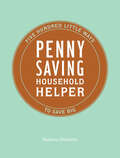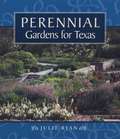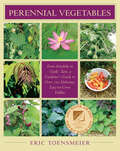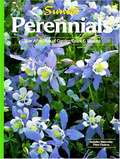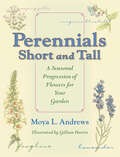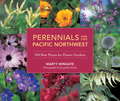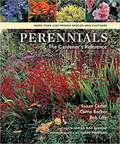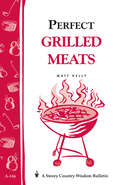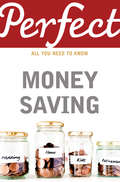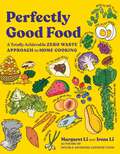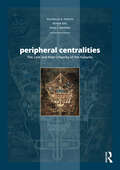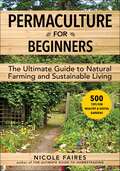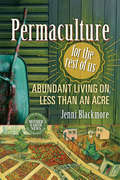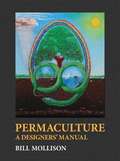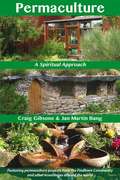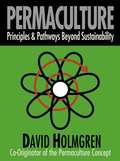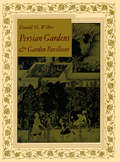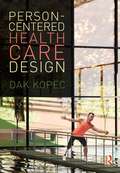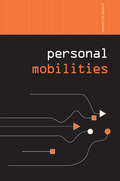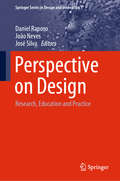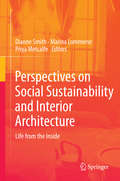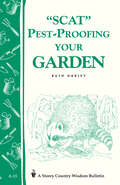- Table View
- List View
Penny Saving Household Helper: Five Hundred Little Ways to Save Big
by Rebecca DiLibertoHundreds of simple strategies to keep expenses down at home (and in the garden)!This handy guide resurrects the fine art of frugal housekeeping with over five hundred tips on saving money throughout the home and garden. Learn creative ways to cut back, pinch pennies, reduce, recycle, and re-use. Want to save on the grocery bill? Buy the whole chicken rather than individual cuts. Get more wear out of your wardrobe? Add a dash of salt to the washer to keep your darks from fading in the laundry. Best of all, Penny Saving Household Helper is a great investment—with these hundreds of tips, it can pay for itself many times over!
Perennial Gardens for Texas
by Julie RyanA perennial garden is an ever-changing source of delight. Each season brings new colors and textures in flowers and foliage. As the years go by, perennial plantings mature and interweave into forms more beautiful and surprising than a season's growth of annuals can ever give. Best of all, a perennial garden can grow almost anywhere with plants suited to local soils, temperatures, and rainfall. This book is a complete guide to perennial gardening in Texas and similar regions of eastern New Mexico, Oklahoma, Arkansas, Louisiana, Mississippi, Alabama, Georgia, Florida, and the Carolinas. In Part One, Julie Ryan offers a historical sketch of cottage gardens and perennial borders, with a sampler of some of their modern variations. In Part Two, she defines the major ecological regions of Texas and, with words and color photographs, takes you on a tour of lovely public and private gardens in each region. You'll find all the "how to" information for creating your own garden in Part Three. Ms. Ryan describes and pictures over 300 flowering perennials, bulbs, foliage plants, and old roses suitable for Texas gardens, with lists of companion annuals, vines, shrubs, and small trees. Accompanying charts provide quick reference to each plant's preferred regions and cultivation requirements. In addition, Ms. Ryan discusses how to design a garden and select plants, prepare the beds, and deal with garden pests. She concludes with substantial lists of resources, including mail-order suppliers of perennials, bulbs, and old roses.
Perennial Vegetables: From Artichokes to Zuiki Taro, A Gardener's Guide to Over 100 Delicious and Easy to Grow Edibles
by Eric ToensmeierForeWord Magazine Book of the Year Award: Home & GardenAmerican Horticultural Society Book Award In Perennial Vegetables the adventurous gardener will find information, tips, and sound advice on less common edibles that will make any garden a perpetual, low-maintenance source of food.Imagine growing vegetables that require just about the same amount of care as the flowers in your perennial beds and borders—no annual tilling and potting and planting. They thrive and produce abundant and nutritious crops throughout the season. It sounds too good to be true, but in Perennial Vegetables author and plant specialist Eric Toensmeier (Edible Forest Gardens) introduces gardeners to a world of little-known and wholly underappreciated plants. Ranging beyond the usual suspects (asparagus, rhubarb, and artichoke) to include such &“minor&” crops as ground cherry and ramps (both of which have found their way onto exclusive restaurant menus) and the much sought after, anti-oxidant-rich wolfberry (also known as goji berries), Toensmeier explains how to raise, tend, harvest, and cook with plants that yield great crops and satisfaction.Perennial vegetables are perfect as part of an edible landscape plan or permaculture garden. Profiling more than 100 species, illustrated with dozens of color photographs and illustrations, and filled with valuable growing tips, recipes, and resources, Perennial Vegetables is a groundbreaking and ground-healing book that will open the eyes of gardeners everywhere to the exciting world of edible perennials.
Perennials
by Sunset Publishing StaffGrow healthy plants with detailed information on planting, caring, and propagation.
Perennials Short and Tall: A Seasonal Progression of Flowers for Your Garden
by Moya L. Andrews“Beginning and novice gardeners will find this book invaluable . . . a colorful palette of well known, dependable plants listed in bloom order.” —Carolyn Harstad, author of Got Sun?Designed for accessibility, this book offers tried-and-true advice on how to keep a yard in bloom. Presented in the sequence in which they bloom, with a chapter devoted to each of the three major growing seasons, 25 varieties of flowers are profiled with accompanying color illustrations. Additionally, Moya L. Andrews provides information about such basic topics as bed preparation, planting locations, weed control, and landscape principles. Andrews also offers practical tips on propagating, transplanting, and dividing perennials, as well as aesthetic considerations such as the use of color outdoors and flower arranging with cut blossoms. Suggestions for flower arrangement and producing indoor blooms in the winter months are also included.“The text descriptions for each of the flowers mentioned, and illustrations of most of the flowers by bloom sequence through the seasons, fills a vacancy in the gardening book market.” —Ezra Haggard, author of Trees, Shrubs, and Roses for Midwest Gardens“Writing in an informative, yet casual style, Moya Andrews gives advice on growing flowering perennials in this guide for both novice and experienced gardeners, passing along her broad knowledge of the subject.” —Chicago Botanic Garden Journal
Perennials for the Pacific Northwest
by Marty WingateThis is the A-List of flowering plants recommended for Pacific Northwest gardens--updated to include the current crop of available perennials--in a lavishly photographed and definitive guide, which will aide in selecting the best perennials to build a successful garden. These are the plants that can winter over and return with showy brilliance the following year, and in the gentle climate of the northwest, there are so many to choose from. But which is the best white flower to plant next to a pink rhodie in a partial-shade setting? And can a garden have pretty perennials without a lot of watering? Figuring out what works well together is such a puzzle! Perennials for the Pacific Northwest explains all of that, plus how best to take care of your plants. It features full descriptions of 500 plants, each of the fully described plants includes a color photograph; selected plants from the lists are pictured.
Perennials: The Gardener's Reference
by Susan Carter Carrie Becker Bob LillyPerennials play a central role in today's gardens. Choosing specific plants, however, can be daunting. Is this plant hardy in my area? How big does it get? When does it bloom? Perennials: A Gardener's Reference answers these and many other questions for more than 2,700 species and cultivars in 250 genera, making it one of the most comprehensive guides available. <P><P>The informative text is enlivened throughout by the authors' wide-ranging experience with perennials and by Lynne Harrison's sumptuous photographs. Whether you're a beginning gardener, a seasoned expert, or a green-industry professional, Perennials: A Gardener's Reference will be the book you turn to again and again for essential information about these supremely beautiful and useful plants.
Perfect Grilled Meats: Storey's Country Wisdom Bulletin A-146 (Storey Country Wisdom Bulletin Ser.)
by Matt KellySince 1973, Storey's Country Wisdom Bulletins have offered practical, hands-on instructions designed to help readers master dozens of country living skills quickly and easily. There are now more than 170 titles in this series, and their remarkable popularity reflects the common desire of country and city dwellers alike to cultivate personal independence in everyday life.
Perfect Money Saving
by Smita Talati- Do you find you're always strapped for cash at the end of the month?- Are you worried about paying your credit card bills?- Would you like some practical advice on how to make your money go further?Perfect Money Saving is the essential guide for anyone who wants to take control of their finances. Covering everything from home-made presents to cheaper mortgages, it gives step-by-step guidance on how to cut your costs without giving up the things you enjoy. With sections on debt management and your financial portfolio, as well as a month-by-month breakdown showing where and when to grab the best bargains, Perfect Money Saving has all you need to make the most of every penny.The Perfect series is a range of practical guides that give clear and straightforward advice on everything from getting your first job to choosing your baby's name. Written by experienced authors offering tried-and-tested tips, each book contains all you need to get it right first time.
Perfection Salad: Women and Cooking at the Turn of the Century
by Laura ShapiroPerfection Salad presents an entertaining and erudite social history of women and cooking at the turn of the twentieth century. With sly humor and lucid insight, Laura Shapiro uncovers our ancestors widespread obsession with food, and in doing so, tells us why we think as we do about food today. This edition includes a new Introduction by Michael Stern, who, with Jane Stern, is the author of Gourmet magazine's popular column Roadfood and the book Eat Your Way Across the U. S. A.
Perfectly Good Food: A Totally Achievable Zero Waste Approach To Home Cooking
by Margaret Li Irene LiA Food & Wine Best New Summer Cookbook A Book Riot Most Anticipated Cookbook of 2023 How to cook flexibly and fight food waste, with 80 recipes and 150 ideas to use up what you have. You’re standing in front of your refrigerator, a week after your last trip to the supermarket. You’ve got a bunch of random veggies, some wrinkly fruit, near-expired milk, and those pricey fresh herbs you bought for that one recipe and don’t know how to use up. For a split second you picture yourself opening a trash bag, throwing everything away, and ordering takeout. We’ve all been there. But instead…you pick up this cookbook. In no time you’ve prepared a Make-It-Your-Own Stir-Fry and How-You-Like-It Savory Pancakes, plus a Mix-and-Match Fruit Galette that you’ll have for dessert. Time to celebrate—you’re saving food, shrinking that grocery bill, and learning some key skills for making the most of what you have. It’s exciting to be able to create new dishes and waste less food, and most importantly—a delicious dinner is on the table! Perfectly Good Food is a book for those moments everyone has, whether you cook for one or a whole household—moments standing before an overfull pantry or near-empty fridge, not sure what to do with an abundance of summer tomatoes or the last of the droopy spinach. Chock-full of ingenious use-it-up tips, smart storage ideas, and infinitely adaptable recipes, this book will teach you why smoothies are your secret weapon; how to freeze (almost) anything; why using your senses in the kitchen (including common sense!) is more important than so-called shelf-life. Written by the chef-sisters behind Boston’s acclaimed Mei Mei Dumplings, this cookbook/field guide is a crucial resource for the thrifty chef, the environmentally mindful cook, and anyone looking to make the most of their ingredients.
Peripheral Centralities: The Lost and Past Urbanity of the Suburbs (Planning, History and Environment Series)
by Paul J. Maginn Roger Keil Nicholas A. PhelpsThe term ‘peripheral centralities’ may seem something of an oxymoron and yet the spatial peripheries of cities have often been more central to urban development processes than is appreciated. To better understand the nature of peripheral centrality, Peripheral Centralities: The Lost and Past Urbanity of the Suburbs brings together a wide variety of examples of lost and forgotten peripheral centralities of different sizes, purpose, geographical location, and political complexion, dating from the first decades of the twentieth century to the present day. Following the introduction, two chapters provide broad overviews of peripheral centralities in international and national systems of centralities. The next four chapters look at plans from settings as different as Dublin and Shanghai that, for one reason or another, failed to materialize. The following eight chapters each describes cases where projects have been realized, ranging from peripheral townships in England to a Chinese steel city. To conclude the book, the editors highlight the themes revealed in the foregoing chapters and consider the part an appreciation of peripheral centralities might play in the development of urban theory from the outside in.
Permaculture for Beginners: The Ultimate Guide to Natural Farming and Sustainable Living
by Nicole FairesTake your garden to the next level—organic, native, and natural! Permaculture is an important but often misunderstood method of growing food and building homes in a manner that works with nature, rather than against it, to create beautiful, healthy, and useful gardens. Blending ecology, organic agriculture, green home design, appropriate technology, and biology can be confusing and overwhelming, but Permaculture for Beginners simplifies this vast field for practical application. This is a hands-on guide, taking the beginner through each step of the design process, so that anyone can apply permaculture principles to their own life. While the principles are simple, the in-depth topics cover every aspect of permaculture, including: Building green homes and passive solar design Growing edible plant communities and forest gardens Using no-till and natural farming methods Creating microclimates for extended growing seasons Raising livestock with ecological foraging techniques Transforming urban backyards into food-abundant oasesThis is a commonsense approach to sustainable living that creates a self-sufficient and low-effort home for the people that live there, whether in the city or the country. Permaculture for Beginners isn&’t a philosophy book, or a dissertation on theory. It is a step-by-step, complete guide to every aspect of permaculture.
Permaculture for the Rest of Us
by Jenni BlackmoreMany of us want to increase our self-sufficiency, but few have access to the ideal five sunny, gently sloping acres of rich, loamy, well-drained soil. Jenni Blackmore presents a highly entertaining, personal account of how permaculture can be practiced in adverse conditions, allowing anyone to learn to live more sustainably in a less-than-perfect world. With a rallying cry of "If we can do it, you can too," she distills the wisdom of twenty years of trial and error into a valuable teaching tool.The perfect antidote to dense, high-level technical manuals, Permaculture for the Rest of Us presents the fundamental principles of this sometimes confusing concept in a humorous, reader-friendly way. Each chapter focuses on a specific method or technique, interspersing straightforward explanations with the author's own experiences. Learn how to successfully retrofit even the smallest homestead using skills such as: No-till vs. till gardening, composting, and soil-building Natural pest control and integrating small livestock Basic greenhouse construction Harvesting, preservation, and moreIdeal for urban dreamers, suburbanites and country-dwellers alike, this inspirational and instructional "encouragement manual" is packed with vibrant photographs documenting the author's journey from adversity to abundance. Jenni Blackmore is a farmer, artist, writer and certified Permaculture Design Consultant who built her house on a rocky, windswept island off the coast of Nova Scotia almost twenty-five years ago and has been stumbling along the road to self-sufficient living ever since. A successful micro-farmer, she produces most of her family's meat, eggs, fruit, and vegetables, in spite of often-challenging conditions.
Permaculture: A Designers' Manual
by Bill MollisonThis edition was compiled for teachers, students and designers as they master the art of assembling conceptual, material, and strategic components in a pattern which functions to benefit life in all its forms.
Permaculture: A Spiritual Approach
by Craig Gibsone Jan Martin BangPermaculture design as divine creative activity. Permaculture looks for the patterns embedded in our natural world as inspirations for designing solutions to the many challenges we are presented with today. It is a philosophical, spiritual and practical approach to the use of the land, integrating microclimate, functional plants, animals, soils, water management and human needs into intricately connected, highly productive systems. In essence, permaculture uses observation as basis for creating sustainable and effective human settlements. The authors discuss the components Earthshare, Fairshare and Peoplecare, with a specific emphasis on the spiritual aspects of the design process. Topics range from soil and plants, energy sources and house design to alternative economics, group process, governance, and spiritual nurturing and enquiry. Examples of existing permaculture structures from around the world, most notably from the Findhorn Community Eco-Village, bring the concepts to life. First-hand accounts of how people got started on their permaculture project lend a personal touch. The first book to look at the spiritual aspects as well as the practical implementation of permaculture design.
Permaculture: Principles and Pathways Beyond Sustainability
by David HolmgrenDavid Holmgren brings into sharper focus the powerful and still evolving Permaculture concept he pioneered with Bill Mollison in the 1970s. It draws together and integrates 25 years of thinking and teaching to reveal a whole new way of understanding and action behind a simple set of design principles. The 12 design principles are each represented by a positive action statement, an icon and a traditional proverb or two that captures the essence of each principle. Holmgren draws a correlation between every aspect of how we organize our lives, communities and landscapes and our ability to creatively adapt to the ecological realities that shape human destiny. For students and teachers of Permaculture this book provides something more fundamental and distilled than Mollison's encyclopedic Designers Manual. For the general reader it provides refreshing perspectives on a range of environmental issues and shows how permaculture is much more than just a system of gardening. For anyone seriously interested in understanding the foundations of sustainable design and culture, this book is essential reading. Although a book of ideas, the big picture is repeatedly grounded by reference to Holmgren's own place, Melliodora, and other practical examples.
Persian Designs and Motifs for Artists and Craftsmen (Dover Pictorial Archive)
by Ali DowlatshahiOver the centuries, Persia (Iran) has borne the brunt of periodic invasions. Elements of these foreign cultures, including Greek, Arabic, Turkish, Mongolian, and European influences, were incorporated into the native artistic tradition but transmuted by Persian artists into a highly original and uniquely Iranian style. This outstanding collection of motifs comprises over 400 examples of this rich tradition, ready for use in a multitude of design areas.Ranging from prehistoric pottery painting to 20th-century calligraphy, this volume spans the full spectrum of Iranian art, including the Achaemenian, Parthian, Sassanian, and Safavid eras. Included are designs drawn from textiles (weaves, printed fabrics, embroidery, carpets), ceramics (pottery and tile), carved and incised work (stucco, stone, metal), miscellaneous ornament, book illustration, and calligraphy.The author, a native Iranian and well-known artist, has carefully rendered designs from original masterpieces in public and private collections around the world. The motifs include floral patterns, geometrics, arabesques, mythical creatures, rosettes, paisley patterns, palmettes, medallions, border and marginal decorations, scrolls, curves, and hunting scenes.Embodying the sumptuous detail, rich texture, and elaborate ornamentation that constitute the glory of Persian art, these motifs also exemplify the Iranian artist's traditional devotion to symmetry, harmonious pattern, and purity of line and form.
Persian Gardens & Garden Pavilions
by Donald N. WilberThis Persian gardening book showcases classic gardens and pavilions and presents gardening advice for the aspiring amateur landscaper looking to add an Eastern flair to his or her yard.The garden has always had a special meaning for Persian (Iran). <P><P>The Persian garden, with its flowing pools, fountains, waterways, rows of tall trees, rich arrays of fruit trees and flowers, and cool pavilions, has represented an image of paradise.Persian Gardens & Garden Pavilions is both a comprehensive survey and an appreciation of this Persian tradition of gardens and garden pavilions. The text traces the historical development of Persian gardens, describes their basic features, presents existing examples, and discusses the literature and tradition behind them. The 119 illustrations include detailed plans and photographs of surviving gardens and their pavilions made on the spot, as well as a comprehensive collection of paintings, lithographs, and drawings of the nineteenth century executed both by Persian artists and by European travelers and emissaries of the period.The author points out, the gardeners who read this book should come across many details and ideas that can be incorporated into their own kinds of gardens.
Person-Centered Health Care Design
by Dak KopecDisease, injury, or congenital disorders result in an inability to perform activities of daily living as effectively as others. Most of these activities take place within and are dependent upon the designed environment. This book presents the specialized area of person-centered health care design, which focuses on a person's design needs because of one or more health conditions and requires foundational knowledge pertaining to infection control, bio-physiology, neuroscience, and basic biomechanics. Whether the designer has engaged in person- or condition-centered design, this book examines the causes that bring about health conditions, such as autoimmune disorders, chronic lung disease, muscular dystrophy, and neurological disorders, and the effects these have on a person's quality of life. Over forty various heath conditions are discussed in relation to assorted building typologies—schools, group homes, rehabilitation and habilitation centers, and more—to identify design solutions for modifying each environment to best accommodate and support a person’s needs. Dak Kopec encourages readers to think critically and deductively about numerous health conditions and how to best design for them. This book provides students and practitioners a foundational framework that supports the promotion of health, safety, and welfare as they pertain to a person's physiological, psychological, and sociological well-being.
Personal Mobilities (Networked Cities Ser.)
by Aharon KellermanPersonal Mobilities provides a systematic study of personal movement focusing on the dimensions of space, individuals, societies and technologies. Kellerman examines a variety of personal mobilities, including air transportation, through several perspectives, examining the human need for movement, their anchoring within wider societal trends, commonalities and differences among mobility technologies and international differences. Although spatial mobility seems geographical by its very nature, the topic has been so far treated only partially, and mainly by sociologists. Personal Mobilities highlights geographical as well as sociological aspects and is the first book to focus solely on personal mobilities.
Perspective on Design: Research, Education and Practice (Springer Series in Design and Innovation #1)
by José Silva Daniel Raposo João NevesThis book presents the outcomes of recent endeavors that are expected to foster significant advances in the areas of communication design, fashion design, interior design, and product design, as well as overlapping areas. The fourteen chapters highlight carefully selected contributions presented during the 6th EIMAD conference, held on February 22–23, 2018 at the School of Applied Arts, Campus da Talagueira, in Castelo Branco, Portugal. They report on outstanding advances that offer new theoretical perspectives and practical research directions in design, and which are aimed at fostering communication in a global, digital world, while also addressing key individual and societal needs.
Perspectives on Social Sustainability and Interior Architecture
by Dianne Smith Marina Lommerse Priya MetcalfeThis book argues that interior architects have a responsibility to practice their profession in collaborative ways that address the needs of communities and of to be the agents of social justice and cultural heritage. The book is divided into three sections, based on three pivotal themes -- community engagement, social justice and cultural heritage. Each section has chapters that put forward the principles of these themes, leading into a variety of fascinating case studies that illustrate how socially sustainable design is implemented in diverse communities across the world. The second section includes four concise case studies of community housing issues, including remote-area indigenous housing and housing for the homeless. The third section offers two extensively researched essays on design and cultural heritage -- a case study of the development of a redundant industrial site and a historical study of gendered domestic interiors. The book appeals to a wider audience than the design community alone and challenges mainstream interior design/interior architecture practitioners nationally and internationally to take a leading role in the field of socially responsible design. The issues raised by the authors are relevant for individuals, communities, government and non-government organisations, professionals and students. "In the twenty-first century we seem to have entered into a new world of knowledge discovery, where many of the most exciting insights come not from the authority of a traditional discipline, but from the dialogue that happens at the hubs and intersections of thought -- the arenas where different disciplines and approaches, different schools and habits of thinking, come together to collaborate and contend. This collection is a good example of this, and I hope the book will be widely read and its lessons learned and applied. " Tim Costello, Officer of the Order of Australia, Chief Executive, World Vision Australia.
Pest-Proofing Your Garden: Storey's Country Wisdom Bulletin A-15 (Storey Country Wisdom Bulletin Ser.)
by Ruth HarleySince 1973, Storey's Country Wisdom Bulletins have offered practical, hands-on instructions designed to help readers master dozens of country living skills quickly and easily. There are now more than 170 titles in this series, and their remarkable popularity reflects the common desire of country and city dwellers alike to cultivate personal independence in everyday life.
Pests of Landscape Trees and Shrubs (Second Edition)
by Steve H. Dreistadt Jack Kelly Clark Mary Louise FlintThis is the ultimate guide to managing landscape pests! With this manual in hand you will be able to diagnose and manage hundreds of insect, mite, weed, plant disease, and nematode pests. Inside you'll find updated information on how to use environmentally safe, ecologically based IPM methods; landscape designs that prevent pests; how to select resistant varieties; advice on the use of less-toxic pesticides such as botanicals, oils, and soaps; and tips on planting, irrigating, and other plant-care cultural activities that help in avoiding problems. Contains over one hundred pages of easy-to-use tree and shrub pest tables; invaluable in helping you identify common pest problems now on over 200 types of ornamental trees and shrubs. Includes 432 color photographs, 117 drawings and tables, references, glossary, and an index.
